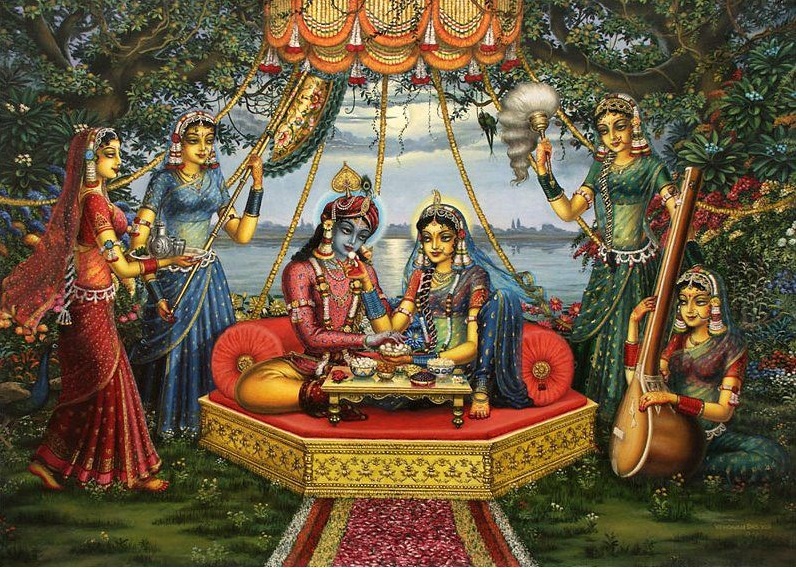Way To Nirapad-Bhumi

Materialistic people are like those people whose behavior is favorable to their desires. They make friendship with such people only. But such is not the case with a ‘Sadhu’. A Sadhu doesn’t look for favorable and unfavorable behaviors. She/he reveres everyone only because god loves everyone. He says “There are uncountable living beings in uncountable worlds and they all are my servants and a part of myself”. Therefore, one who wants to do ‘Bhajan’ must not keep any kind on enmity in his/her heart for any living being. You will say – I don’t like his behavior; I don’t like his attitude, So There are different types of people, all with different attitudes. You must not see that. You must think that this is not natural; all have forgotten their real self, there real nature and hence, behave in an unacceptable manner. It is like an abode of madmen. One who is normal may laugh at those madmen but they don’t take their doings as an offense. Because it is known that they are madmen, their unacceptable behavior is not taken as an offense. Similarly this world is full of mad people. Who is a mad? One who is not natural is not in his senses. The Materialistic people, materialistic knowledge, etc. can’t be natural because they are based on our ignorance of our real self. Materialistic people don’t know who they really are! So aren’t they mad? They don’t know what to do, where to go, from where have they com, where is real peace, so what will you call such a person? Hence, in this sansaar we must think all are mad and therefore, not keep any kind of enmity or prejudice against anyone. We must revere everyone from our heart. This doesn’t mean that there is god in a dog also, so let’s bring a dog in our house and eat together. No this is impossible. If required, we will have to show a stick also to a dog. But in our heart, we must know that God resides in that dog. Then there will be no thought of enmity for anyone. We will give the same dog,a bread and a whip of stick. The whip of stick is only to control the dog; so that it doesn’t come inside our house, but there is no enmity in that. Similarly, God reside in a criminal too, but this doesn’t mean we must bring him in our house and do his sanga, live with him. We must stay away from his ‘Sanga’ instead, though revere him as a part of God, we must think that he is not in his normal self and so he is behaving like this. He doesn’t know what he is doing, what is good for him.
‘Pahle Sajjan Karu Sanga’
We must do sanga of a ‘sajjan’ only and keep respective behavior with everyone, but revere every living being in our heart. Especially, in Case of a Sadhu, We must always revere them as real sadhus, although it is possible that the one looking like a sadhu is not really so . We need not see their attitude, whether he has any good qualities of a sadhu, whether he is a real sadhu or not. We must only see that this is also a sadhu and we must revere him and honour him. This doesn’t mean we must do his sanga! Our Shastras have cautioned very specially on this topic ‘One who takes Harinaam, revere him. One who takes Harinaam and has taken diksha too from a Guru, do seva to him. One who is Sajaatiya, Snigdha(=who isn’t conceited and reveres other’s Shastra-based vieaes), Mahattar(=very good in bhajan and better than you in bhajan) and Aninduka(=doesn’t find faults in others and tell them), do his sanga; otherwise don’t do sanga of anyone. ’ First, we need to see whether the person is Sajaatiya, means- there are many kinds of sadhaks from different religious paths we must do sanga of someone who follows the same path as the path we want to follow. Some are worshippers of Devi Maiya, some worship Mahadev, some worship attribute-less Brahma, some worship Radha-Krishna etc. Suppose you want to worship Radha-Krishna, then you must do sanga of an enlightened worshipper of Radha-Krishna. Otherwise, instead of learning something good, you will start quarrelling with that person. This is inevitable because followers of every spiritual path. Consider their own form of god as the supreme god of the universe. Therefore, first look for a Sajaatiya –Bhakta, Then Snigdha.
The Bhakta should not be proud of his knowledge on Shastras, otherwise if someone put forward even a Shastra-based view which might seem contradicting to his view, he will start quarreling and the ultimate outcome of his sanga can be Apardha. A Snigdha Bhakta reveres others views and tries to find a solution to the two seemingly contradicting views. If he cannot find a solution, then he folds his hands modestly and asks the other person if he could give some solution to the problem.
Then Mahattar. A Mahattar Bhakta does good bhajan and have experience on bhajan. He has all qualities of an ideal sadhu and lives his life like an ideal sadhu. Sadhu mean one who has done Sadhana, i.e. practice. What have they practiced? They now control their mind and body fully. One cannot do will to others by just bookish knowledge. There are hundreds of books in the market, but unless you learn them from an enlightened and experienced sadhu, all are mere knowledge and useless to your spiritual life. When you listen to such a sadhu, his spiritual power and experience affects your body and mind and cause an atomic reaction there. The vibes that enter you by sitting near him, in presence of his spiritual power, power of his Sadhana and effect of his experience in bhajan start an atomic reaction in yourself and cause a change in you. There are sadhus who emit peace and solace and we can experience that just by sitting near him. May be he is quiet but just by sitting near him we feel peaceful. Why does this happen, do you know? It is the effect of the vibes that enter us and cause an atomic reaction. And there are others, if we sit near them we feel something is not right! May be he is quiet, but we just don’t feel right. This is because the vibes that enter us in his presence cause such an atomic reaction inside us that we don’t feel right. Now science is also trying to study this. But this is well described in our Shastras. Especially those who are good in bhajan can determine well who emits what kind of vibes. It’s not that this is a kind of siddhi, but anyone with a pure Antahkaran (=mind/heart) can do this. Therefore, when we listen to a Mahattar Bhakta, his words powered-up by his bhajan, create a change in us. You might have heard the same things anywhere else, but due to the sadhu’s bhajan, only his words change you, affect you and push you forward in your spiritual path. A real Bhakta can never speak a wrong Siddhanta. He never looks at his Siddhantas but speaks with Bhaav, from his heart. Due to kripa of god, he never utters a wrong Siddhanta.
‘Dadami buddhi yogam tam yena mamupayanti te’ (Bhagwat-Gita)
This Knowledge is given by god; it is not present in Jeevatma. Then he destroys all darkness in our heart and light the candle of consciousness. God says in gita that HE does that. But for which kind of Bhakta?
‘Tesam Satata Yuktanam Bhajataam Priti Purvakam’
One who is always connected to god and does bhajan with love. Always connected means- always doing Harinaam, Always remembering and calling god and has no other wish or desire excepts reaching God. This is a Mahattar Bhakta.
Then Aninduka, doesn’t find faults in any creature. When we find faults in others and tell them our spiritual and Sadhana power diminishes. Therefore, we must never find faults in others. This world is full of faults. Who is perfect here?
‘Moha, Tandra, Bhrama, Rukharas, Parishrama, Asatya, Krodh, Aakankha, Aasanka, Viswavibhrama, Ullankam, Vaishamya, Lolota, Mada, Maatsarya, Hinsa, Swed, and Parapeksha’- these are 18 main kinds of faults in every jeevatma. There is not a single person in every jeevatma. There is not a single person in the world who is free of all these faults. Where are you searching for faultless person? You will say sadhu is faultless. No, Sadhu is not faultless but he is able to win over his faults with the help of his conscience. Only when a sadhaks reaches the stage of Prema, He becomes totally faultless. Until then no one is really faultless.
There are four kinds of Kasay. Kasay means these kaam(=desires), Krodh(=anger), Lobh(=greed), etc. which do not let us continue in our path to god. JaagratKasay, SuptaKasay, MurchhitaKasay and NirdhutKasay.
’Kaamkrodhvihinjlhinsadambhavivarjita, lobhmohavihina je te iyovaishnava.’
‘Kasai’ means butcher. These Kasays kill our spiritual path, pose as big obstacles just like a butcher kills his animals. We want to continue in our spiritual path, but the kaam, krodh, lobh, dwesh, etc pose as great obstacles and unable us to continue in our path. On reaching Prema stage, the jad-chetangranthi, i.e. the bond between the living and non-living matter breaks and sadhaks becomes free of all kasays and so, he is called to be in Nirapad-Bhumi, from where he cannot fall.
